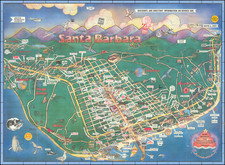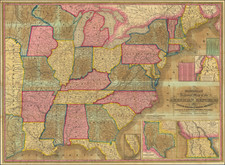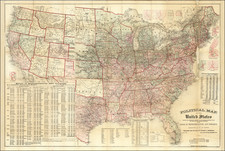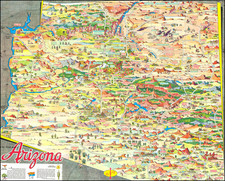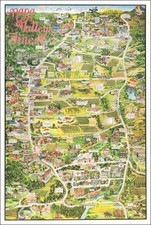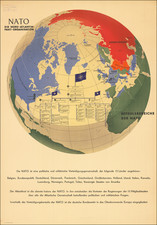The Map Banned By Congress as "Un-American" During the McCarthy Era
Lively pictorial map of the United States, painted by noted radical artist William Gropper, which would become the subject of scrutiny by Joseph McCarthy, Roy Cohn and the anti-communist obsession after World War II.
The map is a fine combination of oral and literary American Folklore, famed for both its popularity among librarians and teachers in the late 1940s and ultimately, its fall from grace during Joseph McCarthy's reign, ending with its being banned following a Congressional hearing led by Roy Cohn.
Ironically, during World War II, Gropper's art work for the US Treasury Department and the White House's Office of War Information brought Gropper a personal thanks from President Franklin Roosevelt," giving pictorial form to specific war information objectives” through propaganda posters and paintings. As noted by Atlas Obscura,
Between 1946 and 1953, the State Department’s Overseas Library Program collected and distributed some 1,744 copies of William Gropper’s America: Its Folklore, a colorful depiction of 61 legends, tall tales, and literary heroes—characters like super-sized cowboy Pecos Bill in New Mexico, steel-driving phenom John Henry in Alabama, and witty trickster Br’er Rabbit in Georgia—superimposed over a familiar projection of the Lower 48.
The purchase was part of postwar efforts to disseminate “facts and solidly documented explanations of the United States.” Based on a painting Gropper completed in 1945, the 34-by-23-inch pictorial map was published by Associated American Artists, and sold by mail order—$5.00 unframed, $14.50 mounted—in the New York Times, Life, and other popular publications. An accompanying 16-page brochure told viewers more about Paul Bunyan, Johnny Appleseed, and their folkloric ilk.
* * *
But the cartographic darling fell from grace in the spring of 1953, when attorney Roy Cohn toured State Department libraries around the world as part of his and Senator Joseph McCarthy’s crusade against Communism. Cohn identified William Gropper as one of the “fringe supporters and sympathizers” whose supposedly Communist-directed works had infiltrated the Overseas Library Program. Gropper was promptly subpoenaed to appear before the Senate Permanent Subcommittee on Investigations—and earned the dubious distinction of being among the first blacklisted artists in McCarthy-era America.
The following is an except of Roy Cohn's examination of Gropper, who would invoke the Fifth Amendment during questioning:
Mr. Cohn: Are you the William Gropper who has prepared various maps?
Mr. Gropper: I don’t understand that question. Prepared various maps?
Mr. Cohn: Did you prepare a map entitled “America, Its Folklore”?
Mr. Gropper: Have you got the map here?
Mr. Cohn: No; I don’t have the map here. Did you prepare a map entitled “America, Its Folklore”?
Mr. Gropper: I painted a map on American folklore, yes.
The map is now quite rare on the market, this being the first example we have offered.
William Victor "Bill" Gropper was an American cartoonist, painter, lithographer, and muralist. A committed radical, Gropper is best known for the political work which he contributed to such left wing publications as The Revolutionary Age, The Liberator, The New Masses, The Worker, and The Morning Freiheit.
Gropper was the eldest of six children. His parents were Jewish immigrants from Romania and Ukraine. His mother sewed at home. His father was university-educated and fluent in 8 languages, but was unable to find employment in America in a field for which he was suited. This failure of the American economic system to make proper use of his father's talents doubtlessly contributed to William Gropper's lifelong antipathy to capitalism.
In 1915, Gropper showed a portfolio of his work to Frank Parsons, the head of the New York School of Fine and Applied Arts. The work so impressed Parsons that Gropper was offered a scholarship to the school. Over the next two years, Gropper gained recognition and awards for his work.
In 1917, Gropper was offered a position on the staff of the New York Tribune, doing drawings for the paper's special Sunday feature articles. At this time, the politically radical Gropper was brought into the orbit of original and innovative artists around the left wing New York monthly, The Masses. After The Masses was banned from the U.S. Mail in 1917, due to its unflinching anti-militarism, Gropper joined artists like Robert Minor, Maurice Becker, Art Young, Lydia Gibson, Hugo Gellert, and Boardman Robinson in contributing to its successor, The Liberator.
Gropper also contributed his art to The Revolutionary Age, a revolutionary socialist weekly edited by Louis C. Fraina and (in later issues) John Reed, a publication which narrowly predated the establishment of the American Communist Party, as well as to The Rebel Worker, a magazine of the Industrial Workers of the World, an anarcho-syndicalist union.
In 1920, Gropper went to Cuba briefly as an oiler on a United Fruit Company freight boat. He left the ship in Cuba and spent some time there observing life and working as a supervisor on a railroad construction detail.
In January 1921, editor Max Eastman formally made Gropper a special contributor and member of the staff of The Liberator.
During the early 1920s, Gropper was a freelance contributor of work to such mainstream magazines as The Bookman (for which he drew caricatures of authors), the liberal magazine The Dial, and Frank Harris' New Pearson's Magazine.
Despite his contributions to a vast array of communist publications, Gropper was never formally a member of the Communist Party USA. In 1927, Gropper went on a tour of Soviet Russia along with the novelists Sinclair Lewis and Theodore Dreiser in celebration of the tenth anniversary of the Russian Revolution. During the second half of the 1930s, Gropper dedicated his art to the efforts to raise popular opposition to fascism in Europe.
The lobby of the Freeport New York Post Office features two murals by Gropper installed in 1938 and titled Air Mail and Suburban Post in Winter. They are included in the listing of the property on the National Register of Historic Places in 1989. The murals were commissioned under the United States Department of the Treasury's Treasury Relief Art Project, which commissioned art for existing Federal buildings. Gropper was also a Works Progress Administration (WPA) artist.
Due to his involvement with radical politics in the 1920s and 1930s, Gropper was called before the House Un-American Activities Committee in 1953. The experience provided inspirational fodder for a series of fifty lithographs entitled the Caprichos.
In 1974, he was elected into the National Academy of Design as an Associate Academician.









